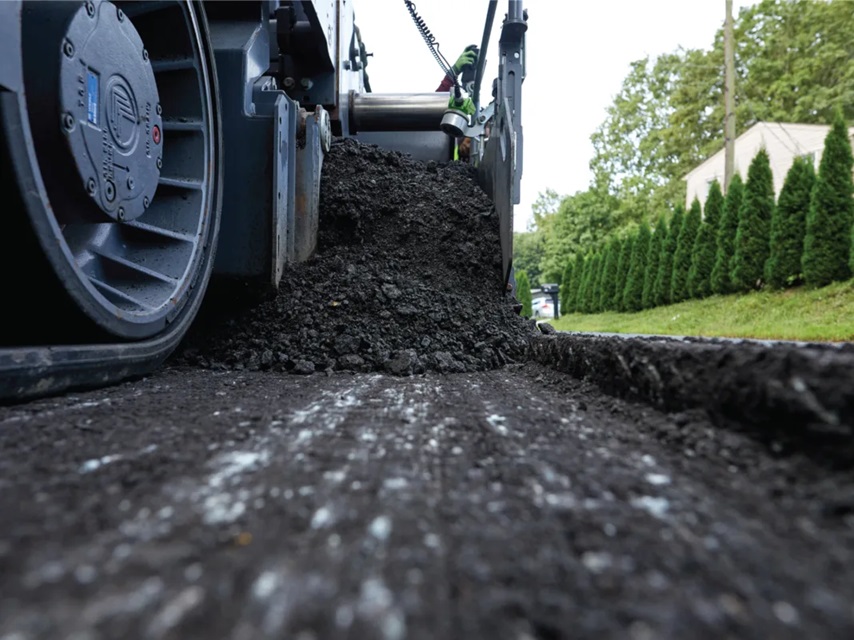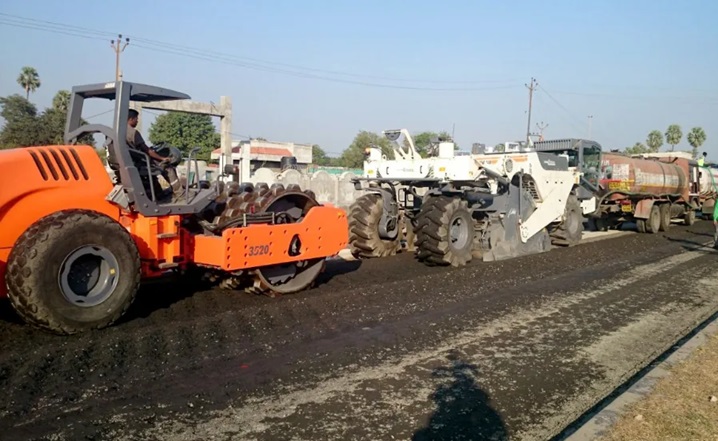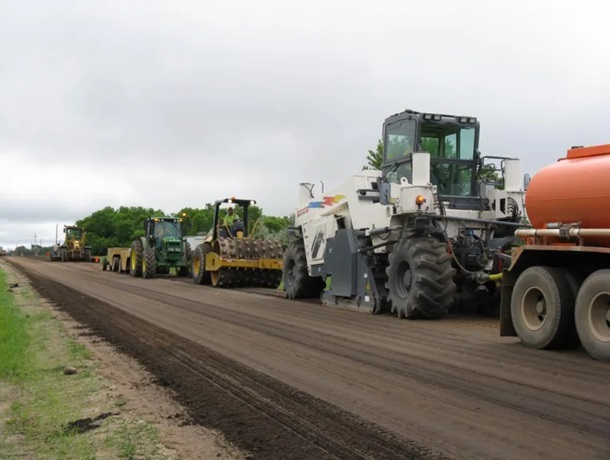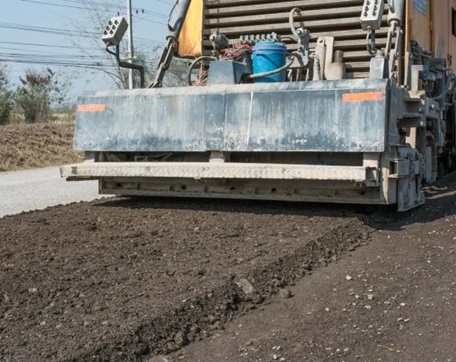Cold In-Place Recycling (CIR) is a road rehabilitation technique that involves the reuse of existing asphalt pavement. It addresses pavement deterioration by milling the top layer of the road and recycling it into a new surface. This process helps restore road quality while enhancing its structural integrity. The technique minimizes the need for new materials and reduces the environmental impact of road repairs. It is often used for improving roads with surface wear, cracks, and ruts, ensuring long-lasting performance with minimal disruption to traffic.
Cold In-Place Recycling (CIR) is commonly applied in the following areas
- Urban Roads: To restore deteriorating surfaces in cities and towns.
- Highways: For rehabilitating high-traffic routes and maintaining road performance.
- Rural Roads: To improve roads in less populated areas, providing cost-effective solutions.
- Airports: For runway resurfacing, ensuring safety and longevity.
- Parking Lots: To restore large asphalt surfaces subjected to heavy use.
- Industrial Roads: For heavy-duty areas that require durable, long-lasting repairs.
- Residential Streets: To enhance local roads, reducing the need for full reconstruction.
How the Technique Works?
- Inspection: Assess the road condition to determine the depth of recycling required.
- Preparation: Clean the road surface and remove obstacles.
- Milling: Grind the top layer of the road surface to remove damaged material.
- Material Modification: Additives like emulsion or cement are mixed with the milled material to improve strength.
- Reprocessing and Mixing: The milled material is reprocessed and mixed evenly across the surface.
- Compaction: The recycled material is compacted using a roller for stability.
- Curing: Allow the recycled material to harden and gain strength.
- Final Treatment: Apply a surface sealant or wearing course for protection.
- Quality Control: Perform a final inspection to ensure specifications are met.
- Reopening: Open the road to traffic after final checks.

The materials used in Cold In-Place Recycling (CIR) for road rehabilitation
- Reclaimed Asphalt Pavement (RAP): The primary material used, consisting of the existing asphalt layer removed from the road surface.
- Recycling Agent: A binding agent (e.g., emulsion or foamed asphalt) added to rejuvenate the RAP and restore its binding properties.
- Aggregate: Additional aggregate (such as crushed stone or sand) may be added to adjust the mix for the desired strength and durability.
- Water: Used to achieve the necessary moisture content during the recycling process.
- Fillers: Materials like lime or cement may be added to improve workability and enhance the structural properties of the recycled mix.
Advantages of Cold In-Place Recycling (CIR) for road rehabilitation
- Reduces overall project costs by reusing existing materials.
- Minimizes waste and conserves natural resources.
- Increases the lifespan of roads with a stronger foundation.
- Minimizes lane closures and delays during repairs.
- Provides a smooth, long-lasting driving surface.
- Utilizes existing road materials, saving resources.
- Reduces environmental impact compared to traditional methods.
- Expedites the road rehabilitation process.
- Enhances the load-bearing capacity of roads.
- Extends the time before major repairs are needed.
- Reduces road surface imperfections and potholes,

Different types of Cold In-Place Recycling (CIR) for road rehabilitation techniques
- Full-Depth CIR: Full-Depth Cold In-Place Recycling (CIR) involves the recycling of the entire thickness of the existing pavement structure. It is ideal for roads that have suffered from significant deterioration, where the full depth of the road surface needs to be rejuvenated. This method not only recycles the asphalt but also ensures that the underlying layers of the pavement are restored to a functional condition. The process typically involves milling the pavement to a specified depth, mixing it with additives such as emulsified asphalt, and then compacting it back into place. Full-Depth CIR is commonly used for major rehabilitation projects where complete resurfacing is required, and it helps in addressing structural issues along with surface defects.
- Partial-Depth CIR: Partial-Depth Cold In-Place Recycling focuses on milling and recycling only the top layer of the existing pavement. This method is generally used for roads that have minor surface damage but maintain structural integrity underneath. The top few inches of the surface are milled, processed, and then recycled with additives if necessary to restore the surface to a functional state. Partial-Depth CIR is an efficient and cost-effective solution for improving the surface condition without the need for extensive milling and deeper interventions. This method is suitable for roads with moderate wear and tear where only surface-level rehabilitation is needed.
- CIR with Additives: Cold In-Place Recycling with additives involves the incorporation of materials like emulsified asphalt, foamed asphalt, or cement to enhance the strength and durability of the recycled mixture. This method is used when the existing pavement material does not have sufficient bonding strength on its own. Additives are mixed with the recycled material to improve its workability, moisture resistance, and overall stability. The use of additives ensures that the recycled pavement structure can withstand heavy traffic and weather conditions, offering a longer-lasting and more durable solution. CIR with additives is particularly useful when the original pavement has a poor quality or when better performance is required.
- Cold In-Place Recycling with a Surface Treatment: After the milling and recycling process, a surface treatment such as a chip seal, slurry seal, or micro-surfacing is applied to improve the texture and durability of the road surface. This method is often used when the underlying structure has been successfully recycled, but the surface needs additional protection against wear, water infiltration, and environmental damage. Surface treatments help seal the recycled material and provide a smooth, durable finish that enhances the road’s performance. It is a cost-effective solution that improves the life of the road without the need for a complete overlay, making it ideal for roads that only require surface-level enhancement after recycling.

Key Equipments Used in Cold In-Place Recycling (CIR) for Road Rehabilitation
1. Milling Machine:
The milling machine is essential in Cold In-Place Recycling (CIR) for road rehabilitation. It is used to remove the damaged asphalt layers of the road surface, which are then ground into small particles. This equipment ensures that the old pavement is effectively broken down and made ready for reuse in the recycling process. By adjusting the milling depth, the machine can cater to different road conditions and provide the right amount of material for recycling. The milled material (RAP) is collected and transported for further processing.
2. Recycling Mixer:
The recycling mixer is used to combine reclaimed asphalt pavement (RAP) with various additives, such as emulsions, foamed asphalt, or other binders, to form a new, usable road material. The purpose of the mixer is to ensure that the RAP is thoroughly blended with the binder to achieve the desired consistency, strength, and durability of the final mixture. The recycling mixer guarantees that the material is homogenous, ensuring uniform performance of the new road surface.
3. Compaction Equipment:
Compaction equipment, including rollers and vibratory compactors, is used to compact the newly laid recycled material. After the paver spreads the mixture, the compaction equipment ensures that the recycled road material is compressed to the appropriate density. This process removes air voids and ensures that the surface is firm, stable, and able to withstand traffic loads. Proper compaction is critical for the durability and long-term performance of the rehabilitated road surface.
4. Paving Machine:
The paving machine is responsible for laying the recycled mixture evenly over the road surface. It spreads the material at the required thickness and width, ensuring a smooth, consistent finish. The paver is adjustable to control the depth of the mixture, ensuring that the surface is uniform and level. This machine is vital for laying down the recycled material properly, before it is compacted, contributing to a high-quality, smooth road surface.
Conclusion
Cold In-Place Recycling (CIR) is an efficient, cost-effective method for road rehabilitation that reuses existing materials to restore road strength and durability. It minimizes disruptions, reduces environmental impact, and offers long-lasting results with reduced maintenance.


